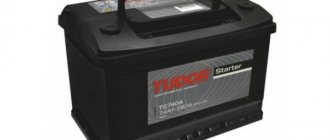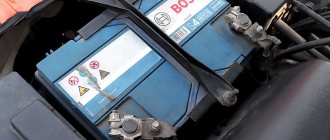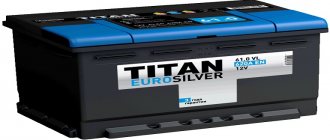To determine the mass, you should look for information on the sticker with the name, brand and characteristics. Some manufacturers indicate the weight of batteries here - but only without electrolyte (only lead and plastic). Although sometimes you can see the mass values taking into account the filling with electrolytic liquid.
Factors affecting battery weight
The weight of a car battery depends on various indicators. Capacity has the greatest influence on this characteristic. Productive models require a larger number of plates, so the active mass of the equipment also increases.
The manufacturer of the car battery also affects the weight. For a number of foreign companies, the value of the indicator may differ from the average tabular data. Although tables with information about the weight of the battery are still needed, their accuracy is quite high.
The approximate weight of the battery can be determined by the type of car. For freight vehicles and buses, this value is in the range of 20–70 kg. Batteries weighing 12-20 kg are usually installed on passenger cars and minibuses. Premium cars, sports cars and SUVs with engines larger than 3.5 liters are equipped with batteries with a capacity of up to 120 Ah, which weigh more than 30 kg.
What parameters are used to choose a battery?
When choosing a battery, parameters such as capacity, starting current, dimensions, and polarity are usually taken into account. The weight of a car battery does not directly affect the choice, but knowing this value will be useful in some situations.
For example, the weight of a car battery may be useful to you if you plan to move the battery from its regular place to some other place. Let's say you started tuning. In this case, it will be useful to know how much a car battery weighs in order to calculate the load on the car’s structural elements and select fasteners to secure it. The weight of the battery is useful if you need to move the battery over a considerable distance. Knowing the weight, you can estimate what equipment you will need for this. And just for general development, it will be useful to know how much the battery weighs. Where can I find this information?
Comparison of the mass of a charged and dry-charged source
Dry-charged batteries are batteries with plates molded at the manufacturer. After assembly, such a battery is charged and hermetically sealed to prevent air and moisture from getting inside. The advantage of this method is its long service life and easy transportation. A battery without electrolyte can be stored for up to 5 years. And it can be transported in any position.
To determine the mass of a source filled with electrolyte, you need to know how the mass is distributed between different parts:
- Plastic. It does not take up the largest part of the battery and weighs a little. The average share of plastic components (partitions, jumpers, body parts) does not exceed 5-7% of the weight. Because of this, plastic is practically not taken into account when weighing a battery at a scrap metal collection point, where it is recommended to take the used source. It is not recommended to throw away used batteries due to the high risk of their components for the environment.
- Electrolytic fluid. Its level can be determined by a scale of two marks (Min and Max), indicated on some battery models. The weight of such a solution of sulfuric acid in distilled water can reach, depending on how full the battery is, up to 20% of the weight of the charged source. When weighed at the collection point, the battery usually remains filled with electrolyte, which is unsafe to drain.
- Lead and its compounds. The heaviest and most valuable part of the device. The share of lead plates in the total mass of the battery can reach 73-79% of the total weight.
Taking this information into account, it can be assumed that a dry-charged battery will have a plastic weight 11-15 times less than the device itself. The mass of electrolyte, which is added to the battery when installed on a car, is approximately equal to 1/4 of the total weight. These values can be compared with real numbers. For battery 6 ST-55, the body of which indicates 11 kg, the plastic part weighs about 0.8 kg, and the electrolyte (at the maximum fill level) weighs 2.5 kg. The total weight of the device is 14.3 kg, the proportion of plastic is 5.6%, lead is 77%, liquid is 17.4%.
What does the weight of a battery consist of?
A standard starter-type battery is a structure consisting of a plastic monoblock containing lead plates and electrolyte.
Its mass consists of several components:
- plastic case;
- volume of electrolyte;
- the amount of lead component, which accounts for about 60-70% of the battery's weight.
The weight of the battery case in most cases is about 0.5 kg. The volume of lead in it is within 12-13 kg, depending on the container and brand. In addition, its design includes an electrolyte consisting of sulfuric acid and distilled water.
The main components of any car battery.
Shell
The battery monoblock, or shell, is a body made of polypropylene or ebonite, which serves as a reservoir for the electrolytic solution. Inside it is divided into several cells:
- 3 – for batteries with a voltage of 6 V;
- 6 – for batteries with a voltage of 12 V.
The cells contain positive and negative electrodes in the form of lead grids immersed in the electrolyte and separated from each other by separators that protect them from contact with each other and the occurrence of a short circuit.
The top of the battery case is covered with a cover welded to its base, designed to protect it from mechanical damage. Such a lid is often equipped with special devices for removing gases.
Lead
Starter batteries are manufactured using various technologies, but the most common are lead-acid batteries. One of their main components is lead and alloys based on it. This metal is recyclable and is used to make battery plates.
Electrolyte
The electrolytic solution that fills the battery case is a solution of sulfuric acid diluted with distilled water in the prescribed proportions. Depending on the degree of its charge, the density of the electrolyte may vary. In a fully charged battery, this figure is in the range of 1.127-1.300 g/cm³. During the discharge process, an electrochemical reaction occurs, leading to the consumption of sulfuric acid and a decrease in density.
The density of the electrolyte is measured using a hydrometer in each battery bank. It is optimal to carry out such a check every 15-20 thousand km of the car.
Battery weight depending on type
It is possible to calculate the approximate mass of electrolyte, plastic jumpers and lead parts only for the most popular type of battery - lead-acid. Determining the same indicators for alkaline batteries is a more difficult task. The exact values can only be found in the technical documentation.
On the other hand, alkaline batteries are practically not used in cars. Although they have many advantages - a minimum percentage of self-discharge and evaporation of electrolytic fluid, a high starting current. The reasons for refusing such sources are their high price and large size.
Helium, alkaline and others
Technological progress has led to the emergence of new types of batteries on the market. The following types are currently available in stores:
We recommend: How to choose a 90 A/H battery based on price and features of modern batteries
Antimony batteries are a classic type of battery that contains 5% antimony in its lead plates. This is a serviceable type of battery that requires constant monitoring of the electrolyte level and its density. Nowadays these batteries are going out of service, but they are still found.
Low-antimony batteries contain less antimony, but also require care and control. Their advantage is their low sensitivity to voltage fluctuations in the vehicle’s on-board network, which is not uncommon for products of the domestic automotive industry.
Calcium batteries have a much lower self-discharge rate than antimony models. They retain their properties well during long-term storage, are convenient and reliable in use. Their disadvantage is the need for a stable voltage in the vehicle network, as well as sensitivity to low discharge. It is enough to severely discharge such a battery several times, and it can be thrown away.
Alkaline batteries use alkali instead of acid. Such batteries are significantly more expensive than acid batteries, but have a number of advantages. They are insensitive to strong discharge , resistant to operation at low temperatures and have relatively low self-discharge. The disadvantage of batteries is the so-called memory effect, when when discharged to a certain limit, the battery “remembers” it and the next time it is discharged it only works up to this limit. Alkaline batteries are often used as traction batteries rather than starter batteries.
In gel batteries, the electrolyte is in the form of a gel. This made it possible to solve the problem of its fluidity, so such AMBs can lie on their sides and nothing will leak out of them. They are not without their drawbacks. Gel batteries must be charged in a gentle mode; excess voltage can even lead to a battery explosion or swelling. These batteries are also sensitive to low temperatures, when the gel thickens even more and loses its properties.
We recommend: Car battery diagnostics
AGM batteries are a type of gel battery and are distinguished by the presence of absorbent plates between the plates, which allows for better retention of the gel. These batteries are maintenance-free, they are quite inexpensive, but they are not very durable.
Lithium-ion batteries. This type of battery is used everywhere in all types of gadgets, but its use as starter batteries is very limited. Mainly due to sensitivity to low temperatures. Batteries of this type are more used as traction batteries in electric vehicle designs; they have a special function for heating them.
Dependence of mass on capacity parameters
The easiest way to determine the weight of a battery is by its capacity:
- A battery with a capacity of 35 Ah, installed on small cars of domestic and foreign production, when filled with electrolytic liquid, can weigh up to 10 kg;
- the weight of the most popular models for passenger vehicles (55 and 60 Ah) is 13-16 kg;
- when the capacity increases to 65 Ah, the weight increases by another 10%, reaching 16-18 kg - such batteries are considered universal and are suitable for any passenger car, including SUVs;
- The weight of the 75 Ah model, suitable for cars with an engine capacity of up to 2.85 liters, is in the range of 20-24 kg.
Car batteries with a capacity of 90 Ah, which are usually installed on trucks and construction equipment, can weigh from 20 to 30 kg. The heaviest batteries include models with 190-225 Ah. You can find such equipment on truck tractors, and its weight reaches 50-70 kg.
Car battery sizes
Unlike weight, the size of a car battery must be the overall dimensions when purchasing it. Battery sizes do not exist on their own and are not pulled out of thin air by manufacturers. In many ways, they are determined by the main parameters that characterize the operation of the battery: capacity and starting current. The higher these indicators are, the more electrodes and the volume of active mass are required. Accordingly, the size of the battery case increases. Surely everyone has noticed that batteries for trucks with large capacities are larger in size than those for cars. Precisely because they contain more plates in their composition.
The easiest option when buying a battery is to choose one with the same dimensions and performance as the previous battery. But to help you get your bearings, let’s look at the main battery sizes on the modern market.
European size
European standard battery sizes are suitable for use in European and domestic vehicles. In appearance, they can be immediately distinguished by the terminals recessed in the battery cover.
Asian size
The dimensions and appearance of an Asian battery are noticeably different from European ones. The battery terminals are flush with the plane of the cover, and the body itself has a greater height and shorter length. Please note that most cars from Asian manufacturers have exactly these batteries. In addition to differences in size, these batteries are mounted differently in the engine compartment. For the European type, the fastening is carried out by the protrusion at the bottom of the battery case, and the Asian type battery is pressed with a bar on top using screw clamps. Therefore, you need to buy a battery with dimensions and type similar to the old one. Otherwise there will be problems with the installation.
American size
The North American battery is similar in size to the European type, but has different dimensions. They are located on the side of the long side of the battery. The terminals have internal threads and the terminals are attached to them using bolts. This design is used on vehicles that are supplied to the North American market. In Russia, batteries of this type are not very common.
Below you can see a table where batteries with different capacities are collected. Perhaps it will help you navigate when choosing a battery.
| Length x Width x Height, mm | Standard size | Capacity, Ah |
| 187x127x227 | Asia | 35 |
| 187x127x227 | Asia | 40 |
| 175x175x190 | Euro | 42 |
| 207x175x175 | Euro | 44 |
| 238x129x227 | Asia | 45 |
| 207x175x190 | Euro | 52 |
| 242x175x190 | Euro | 60 |
| 232x173x225 | Asia | 60 |
| 242x175x190 | Euro | 60 |
| 242x175x175 | Euro | 61 |
| 242x175x190 | Euro | 62 |
| 242x175x190 | Euro | 63 |
| 232x173x190 | Asia | 65 |
| 261x175x220 | Asia | 70 |
| 278x175x175 | Euro | 72 |
| 278x175x190 | Euro | 74 |
| 278x175x190 | Euro | 77 |
| 315x175x175 | Euro | 80 |
| 353x175x190 | Euro | 95 |
| 306x173x225 | Asia | 90 |
| 306x173x225 | Asia | 95 |
| 353x175x190 | Euro | 100 |
| 390x175x190 | Euro | 110 |
| 513x189x223 | Euro | 140 |
| 518x240x242 | Euro | 180 |
| 518x240x242 | Euro | 200 |
| 518x240x242 | Euro | 225 |
| Length x Width x Height, mm | Standard size | Capacity, Ah |
comparison table
In order to avoid calculations and weighing, the mass of car batteries can be determined using a special table. It shows the average performance of all batteries, including the weight of a dry-charged source and one filled with electrolyte. More accurate figures for models of the popular brands Forse, Titan, Banner and Boost - but taking into account their filling with electrolytic fluid.
Average mass values of lead-acid batteries.
| Capacity, Ah | Average weight of lead-acid battery, kg | Weight of products from well-known manufacturers, kg | ||||
| without electrolyte | with electrolyte | Forse | Titan | Banner | Boost | |
| 35 | 8 | 10 | ||||
| 40 | 9 | 11 | 11 | 11 | ||
| 45 | 10 | 12 | 12-13 | 12 | ||
| 50 | 11 | 13 | 13 | 14 | 12-13 | |
| 55 | 12 | 15 | 16 | 14-16 | 14.1 | 13 |
| 60 | 13 | 16 | 16 | 15 | 17 | 16 |
| 65 | 14 | 17 | 17 | 16 | 16-17 | |
| 70 | 15 | 18 | 17-18 | 17-18 | ||
| 75 | 16 | 19 | 18-20 | 19 | ||
| 90 | 21 | 23 | 21 | 22 | ||
| 95 | 21 | 24 | 25 | 22-23 | ||
| 100 | 22 | 25 | 24 | 28 | 23 | |
| 110 | 26 | 30 | 28 | 26-28 | ||
| 135 | 34 | 38 | 39 | |||
| 190 | 48 | 58 | 52 | |||
| 225 | 51 | 62 | 60 | 58 | 62-63 | 60 |
How much does a car battery weigh?
Passenger cars are supplied with starter batteries. And although the battery has a shorter service life compared to a car, it is designed to work in conjunction with a generator. When replacing, it is better to purchase a battery identical in size and capacity.
It’s useful to know what batteries the industry can offer, how much a 55 Ah car battery weighs, and why you can’t install a 75 Ah battery instead. And the reason is simple. By installing a larger capacity battery and not changing the generator, you will always use an undercharged source of energy. This will quickly lead to loss of excess capacity and sulfation of the plates will occur. In addition, you will receive a load in the form of extra useless weight of the battery, and you will have to redo the installation location.
You can find out the weight by finding the information on the car battery label. But it is necessary to take into account that the value presented does not take into account the electrolyte. Using the table, you can determine the actual weight of a car battery without having a scale or table at hand.
All batteries vary in assembly configuration. It can be “European” and “Asian” and “American”. They differ in size, shape and method of attachment. The terminals are located differently in them. Therefore, when replacing, you need to focus on the type of battery and replace it with a similar one.
Table: Weight of car batteries of different capacities
| Capacity Ah | Battery Type | Dry weight kg | Electrolyte kg | Refueled kg |
| 55 | 6ST-55 | 12,1 | 2,5 | 14,6 |
| 60 | 6ST-60 | 13,2 | 2,2 | 15,4 |
| 66 | 6ST-66 | 14,3 | 2,6 | 16,9 |
| 75 | 6ST-75 | 15,5 | 3,5 | 19,0 |
| 90 | 6ST-90 | 20,5 | 2,6 | 23,1 |
| 100 | 6ST-100 | 21,8 | 2,6 | 24,4 |
| 190 | 6ST-190 | 47,9 | 1,2 | 49,1 |
The table shows how much the most common 55Ah car battery weighs - about 15 kilograms. Even a weak car enthusiast can install it in place.
conclusions
Despite the fact that the most accurate way to find out the mass of a battery is to weigh it, it is possible to do without using a scale. Tabular data allows you to determine approximate values, which are sufficient for most situations. If the average numbers are not suitable, the battery will have to be weighed, not forgetting about the rules for handling such equipment. When moving the battery, do not turn its case over. Electrolyte should not come into contact with the skin or mucous membrane of the eyes. In case of accidental contact with liquid, immediately rinse the affected area with water and seek medical attention.
https://www.youtube.com/watch?v=dxQ5ksE8nng
You may also be interested.
Batteries 0
General battery marking requirements
The marking of devices and, accordingly, their decoding may be different, it all depends on the manufacturer of the device . Also, the marking may be different depending on the type of device, because different batteries are produced for different types of vehicles (cars, trucks, minibuses, special equipment). And in this case, we mean not only standard sizes, but also capacity, current strength, as well as other technical features. The marking itself may even differ depending on the country in which the battery is used, however, there are still some conditions that manufacturers take into account. This is because these conditions are prescribed in the standards.
Regardless of the manufacturer and type of battery, the following information will be indicated on its case:
Photo gallery “Main faults”
Designation of Russian devices
All devices manufactured in the Russian Federation must comply with standard 959-01.
If you look at the body of such a battery, you can see the letters:
Separately, we need to talk about the last marking symbol.
To more correctly determine the type, use the following decoding:
For which cars is it most suitable?
The 55Ah 12V battery, whatever one may say, is an option for cheaper cars from Europe, Asia or Russia. In the United States they like more powerful engines, and for them, accordingly, a different battery is needed.
The volume must be selected based on the design and capacity of the engine. It is also important to consider what fuel the car runs on.
- Carburetor engine – 1.2–1.6 liters.
- Injection - 1.6–2.2 l.
- Diesel – up to 1.5 l.
If your car has a lot of different electrical equipment installed, then you need to choose a more powerful battery - for example, 60 or 62 Ah.
This rule also applies to residents of northern regions where there are severe frosts. But when purchasing, be sure to check what the cold cranking current of the product is - it should also be higher.
What is mass formed from?
Each car battery has its own specific weight, shown on the sticker in kilograms (kg).
Yes, mass does not play as significant a role when choosing a battery as capacity or starting current, but sometimes even such information can become decisive.
When selling used batteries, when the main value is lead, many mistakenly perceive the total weight as a figure for calculating the profit from the sale. In fact, old batteries are not accepted by total weight, but only by the mass of lead they contain.
There are 3 components that form the final weight of the power supply. Here we are talking specifically about lead-acid batteries:
It is important to understand that not only pure lead is taken into account, but also various alloys and compounds.
Moreover, the selling value is mainly pure lead, of which not much can be obtained in modern batteries through conventional processing. Basically, it has to be separated from other metals, which requires special equipment and high-temperature treatment. At home, it is usually possible to smelt no more than 20% of the total amount of lead contained in the battery.
Operating principle of 60 Ah battery
Before you start charging, you need to make sure that the motorist knows how the battery works. Only there will it be possible to use it correctly.
Amp and hours. Battery capacity is measured only in amperes/hour. This means that a 60Ah battery will deliver 60A in one hour. If the load drops to approximately 30 Amperes, then it will supply for 2 hours and so on.
Voltage. Many people mistakenly believe that the voltage should be 12 Volts. But this is not entirely true. The optimal value is 12.6-12.7 Volts . This indicator means 100% charge.
We can conclude that 12 Volts is a battery with a charge level reduced by 40 or 50%.
But with this indicator the car will drive. If the car is fully operational and the generator recharges it, the voltage will soon reach the required value. If the battery shows 11.5-11.6 Volts, then the charger is deeply discharged. At this point, the lead plates will begin to sulfate and the machine will not start.
Auto battery structure
Basic conditions when choosing
A car battery is made of sulfuric acid and water. When the battery is charged, the positively and negatively charged lead plates are converted to lead sulfide, and the electrolyte loses a large amount of sulfuric acid, becoming mostly water. When it is charged, the negative plates consist of:
- lead;
- positive lead dioxide plates;
- electrolyte - to restore the previous density.
Be careful when using car batteries, as the acid, as well as any residue that may form on the battery casing, will lead to corrosion. Inspect your battery as often as possible, and wear hand and eye protection when handling it.
Battery capacity
Determined by the number of Ah. This is the amount of energy that is generated in the battery at a certain voltage in a certain period of time (hour). Most often, the car manufacturer recommends a range of indicators for optimal performance.
Inrush current (DC)
This is a battery starting power meter. Choose car batteries that meet the requirements of the car; for this, consult the owner of the vehicle (vehicle) or study the vehicle owner's manual . The starting current can usually be found on the battery label. This three-digit number indicating CT, measured in Amperes, is located after the capacity (in A-hour). The higher this indicator, the more easily the crankshaft starts through the starter, the better the “spark” on the spark plugs works and the faster the car starts. The most important indicator at strong subzero temperatures.
Cold cranking current (CCC)
This is the same DC meter that was tested at 32 F or 0 C. If you live in a cold climate, this is an important note. Temperatures below freezing may produce only 50-60 percent of the charge, as the chemistry in the battery case is slowed and weakened.
Rated voltage
Measured in volts. There are three voltage values characteristic of batteries intended for various types of transport .
- 6 V - batteries with such a low voltage are used only for particularly light motorcycles.
- 12 V is a characteristic of almost all batteries used in modern cars, trucks, and most motorcycles
- 24 V - similar batteries are installed on large trucks, buses, trolleybuses, etc.
Car battery polarity
Polarity is a key indicator for correct installation of the device in the car. It is determined by the arrangement of current leads and can be direct or reverse. Choosing a current terminal circuit that is inappropriate in design may result in the wires not reaching the corresponding terminals.
To determine the polarity, you need to place the battery towards you with the side where the terminals are located. They must be marked with “+” and “-“ signs. If the terminal with the “+” sign is on the right, then this battery has reverse polarity, if the terminal with the “+” sign is on the left, then this battery has direct polarity.
Basic battery parameters
Each battery has a number of characteristics according to which they can be classified and combined into groups. These are the following parameters:
- Capacity. Measured in ampere hours (Ah). Shows how long the battery can operate under a fixed load. If the battery capacity is, for example, 55 Ah, then the battery must be guaranteed to produce a current of 1 ampere for 55 hours until it is completely discharged.
- Starting current. An important characteristic that must be taken into account when selecting a battery according to its parameters. Indicates the maximum amount of current that can be supplied by the battery when a powerful consumer, such as an engine starter, is connected to the network.
- Battery type. They can be serviced or unserviced. Serviced models require constant monitoring and care. Maintenance-free ones do not require this, but they are significantly more expensive.
- Dimensions. Any battery is a rather large unit, and in conditions of limited engine compartment space it must be placed somehow. Especially with the modern layout of the engine compartment, when all the units are very close to each other.
- Mounting type. The battery case has special protrusions on the bottom, which are used to attach it to the car body. Such beads can be on the front and back. They may also not be there at all and the battery is attached with a special strip on top.
- Type of current carrying terminals. They can be recessed into the body (European type) or protrude from above (Asian type). This parameter affects the height of the battery as a whole, as well as the ability to connect the car’s wires using standard connectors.
- Polarity. There is direct and reverse. It differs only in the location of the positive and negative terminals: left or right. If you do not take this feature into account, the length of the supply wires may not be enough and they will have to be increased.
We recommend: Varta Battery (Varta Black Dynamic)
The choice of battery according to parameters is made taking into account all these characteristics. As a rule, all these parameters are indicated by the manufacturer in the battery description.
( 2 ratings, average 4 out of 5 )











